BY KEVIN A. GALLAGHER
Jerry Knapp’s report on the fire in West Haverstraw, New York (in this issue), determined to be caused by discarded smoking material near the front porch, appeared to me to be déjà vu. In 2008, the Acushnet (MA) Fire & EMS Department (Acushnet) responded to a reported porch fire at a two-story Colonial house. In the four minutes it took the first-arriving police officer to get on scene, the structure was fully involved. That fire made us—and the fire service—aware of the dangers posed by certain techniques used in residential modular construction. Our findings served as the basis for my article “The Dangers of Modular Construction” (Fire Engineering, May 2009, http://bitily/1cXdci9). These findings also served as the foundation on which additional information and experiences have been added for several Fire Department Instructor Conference presentations on this topic.
![(1) The fully involved, two-story modular home fire in Acushnet, Massachusetts. [Photos courtesy of Acushnet (MA) Fire & EMS unless otherwise noted.]](https://emberly.fireengineering.com/wp-content/uploads/2013/10/galllagher-1-1310fe.jpg) |
| (1) The fully involved, two-story modular home fire in Acushnet, Massachusetts. [Photos courtesy of Acushnet (MA) Fire & EMS unless otherwise noted.] |
The Acushnet and West Haverstraw fires, along with fires across the country, including the fire in May 2012 in Carmel, New York,1 that killed a police officer and members of his family (caused by ash from smoking material that ignited plastic lattice near the front porch), demonstrate the intense speed at which fire can spread in a modular home. For several years now, we have worked to address several construction techniques unique to the modular industry we believe are inherently dangerous to building occupants and firefighters when a fire moves beyond the contents and finds its way into the structure.
MODULAR CONSTRUCTION CONCERNS
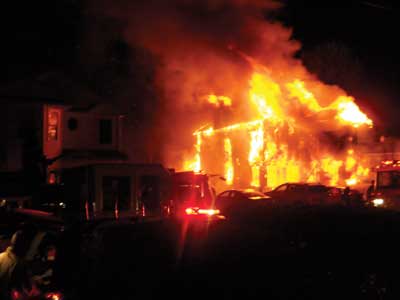 |
| (2) The fully involved, two-story modular home fire in West Haverstraw, New York. [Photo courtesy of West Haverstraw (NY) Fire Department.] |
- Void Spaces: Modular structures of more than one level can have a significant void space between levels of habitation. When the modules (boxes) arrive on scene, one is placed on top of the other. They do not fit snugly together like puzzle pieces. Instead, a void space of up to 20 inches in height can be created. This void runs the full length and width of the corresponding boxes. If this void were vertical, we would have balloon-type construction; since it is horizontal, we instead have a mini cockloft praised by contractors for the ease of running services (electrical, HVAC, and so on) and feared by firefighters because of the threat of undetected fire spread.
 |
| (3) The structural remains of the Acushnet fire. |
It is important to keep in mind that the boundaries of this void space are the floor decking above and the ceiling below. As Gary Bowker, in “Fighting Fires in Disposable Buildings” (Fire Engineering, March 2013), reminded us: “It is noteworthy to point out, however, that UL, in ‘Structural Stability of Engineered Lumber in Fire Conditions,’ an accompanying live fire testing video, indicates that thermal imaging cameras may not be able to effectively ‘see’ through wooden floor decks covered with carpet and padding. The test shows a raging basement fire directly underneath the wooden floor deck constructed with wooden I-beams. Catastrophic failure of the floor occurs six minutes after fire exposure begins, plunging two firefighter manikins into the inferno. The UL video dramatically illustrates what can happen to unknowing firefighters who ‘rush through the door and then fall through the floor.'” Conceivably, a crew could be searching the floor above a room-and-contents fire confined to the A/B corner of the structure, but the fire had already spread 48 feet to the A/D corner through the void and is raging directly below them. How could the fire enter the void space? The answer may surprise you.
- Polyurethane Foam Structural Adhesive: As the 2009 article on this topic reported, research conducted by the Worcester (MA) Polytechnic Institute (WPI) showed that when the glue commonly used to affix ceilings to their structural supports is subjected to heat (35 kW/m2, or the energy produced in a waste basket fire), it burns hot (Peak Heat Release = 241 kW/m2) and fast (time to ignition = 7 seconds during a 163 second test) and loses most of its mass (75 percent of mass lost).2 Tests conducted by engineers on behalf of the modular industry confirmed these findings.3 It is important to note that the International Residential Code allows glue to be used in place of mechanical fasteners in modular construction as the result of an administrative clause that allows “alternative methods and designs.” You would think that this “alternative” system would have been vetted in such a way as to ensure that when subjected to high heat conditions, the ceiling would remain in place for as long as the mechanical fasteners they are replacing.
 |
| (4) Inside typical void space in multilevel modular residence. |
During discussions with Massachusetts code developers, the modular industry offered to conduct tests they were convinced would demonstrate the bonding capabilities of the glue and put our concerns to rest (also known as shutting up the fire service). Those tests were promised in 2011. Despite stating, “It is still our intention to provide the BBRS (Massachusetts Board of Building Regulations and Standards) with data from the testing of assemblies that will resolve the current allegations,”4 to this date the data collected and any references to the alleged tests have not been provided.
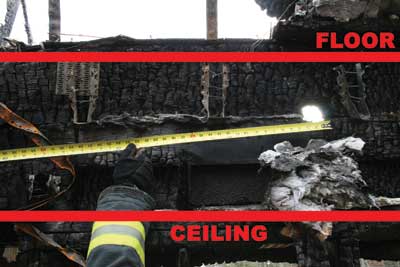 |
| (5) The boundaries of void space defined post-fire. |
Although the industry may want to avoid shedding light on this concern, scientists at WPI did not disappoint. After conducting a thermal gravimetric analysis (TGA) test, the lead researcher stated in an e-mail to me that decomposition of the glue begins at 250°C or 482°F.5 Knowing that ceiling temperatures can exceed 1,000°F in a contents fire, we should be very concerned that the glue would begin decomposing (changing from a solid to a liquid) directly over the fire very quickly.
In addition, knowing that the ceiling is the lower boundary of the void space in multilevel construction, any degree of ceiling failure, from full sheets to minor openings from the gypsum board’s sagging, can provide a pathway. WPI researchers have stated that once decomposition begins, the mechanical strength of the glue decreases and that once in the void space, there is nothing to stop the fire from spreading. In fact, the structural contents of the void space consist of lumber and glue that produce flammable vapors at less than 500°F, leading to the reality of exceptionally rapid fire spread.
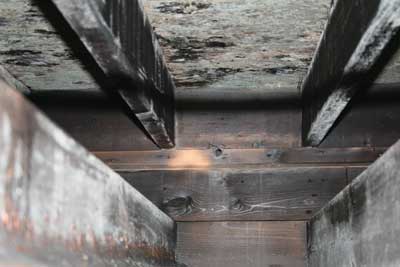 |
| (6) Inside void space post-fire. |
Let’s take a minute and look closely at this process of attaching ceilings with only polyurethane glue. Gypsum board is composed of three components: the front paper, the “chalk” core, and the back paper. When a mechanical fastener is used, all three components come into play. In addition, the fastener anchors the gypsum to the structural member. The size of the fastener is driven by a code schedule based on the thickness of the gypsum board. When glue is used, it is sprayed as a bead along the point of contact of the gypsum board and structural member. The glue bonds to the joist and to the back paper only. There is no anchoring or involvement of the other two components of the gypsum. The glue, which we now know begins the process of changing from a solid to a liquid at relatively low temperatures in a fire event, is all we have holding the ceiling in place and protecting the lower boundary of the void space.
ACTIONS TAKEN
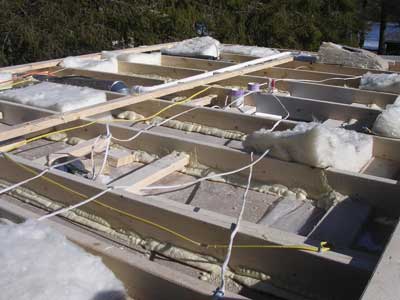 |
| (7) Looking into the ceiling assembly of a modular home under construction, this will be the lower boundary of the void space. Note the use of adhesives. |
In Massachusetts, we changed our state building code to remove the “alternative methods and design” loophole in the International Residential Code. All modular construction coming into our state is required to contain mechanical fasteners. The push-back from the modular industry was, as expected, claiming excessive regulation, the loss of jobs, and the usual arguments. The industry’s failure to provide testing data on the glue sealed the deal for code developers. The Massachusetts language, highly recommended for your state or local jurisdiction, is as follows:
“Massachusetts State Building Code 780 cmr 57.00 wall coverings: 5702.3.5.1 Ceiling attachment. Effective January 13, 2011, only designs or methods that use mechanical fasteners in accordance with 780 CMR Table 5702.3.5 shall be used for attaching gypsum board to ceilings in buildings governed by this code including manufactured buildings. Alternative designs, such as using adhesives only, are not permitted.”
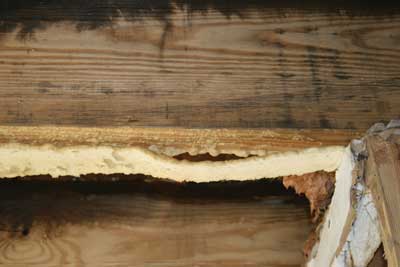 |
| (8) Polyurethane foam structural adhesive used to bond the back paper of gypsum board to the surface of the wood joist. |
Efforts are underway in Massachusetts, led by the state’s Fire Chiefs Association and fire marshal, to reduce the size of the void space in modular buildings. The current code requires draft stopping in voids with an area of 1,000 square feet. This code fails to address the large voids created by volume measurements (length × width × height). Reducing the size of the void by requiring a blockage in the space would slow the spread of smoke and heated air.
It is important to note that draft stopping is not designed to block fire, but any opportunity to slow what is otherwise a rapid process can only prove helpful to both building occupants and firefighters. Modular industry representatives are fighting this initiative, claiming increased cost of construction. However, documents they submitted to code developers6 reveal a relatively easy fix at an additional cost of $350 per void space or $700 per two-story home (less than a leather couch).
The modular industry may want to ignore these concerns, but one of its member facilities has been proactive. One manufacturer decided to stop using glue in its construction process and to fill the void space between levels of habitation with nonflammable insulation. This business decision was made after the 2008 Acushnet fire. The comments of the company’s general manager in a letter to me are of interest: “This item of mechanical fastening our sheetrock has not hurt our production as you saw when you toured our factory. I have not had to lay off workers because I cannot use the foam adhesive. I have not lost profits because I cannot use foam adhesive. I can sleep good at night knowing that I do NOT have foam adhesive in OUR homes.”7
Keep in mind that if we were able to change the codes tomorrow and eliminate the use of the polyurethane glue and reduce the size of the void space, these problems would go away from that date forward. What we, as firefighters and fire officers, need to be mindful of are the thousands of modular structures already built in our communities that match this profile.
The similarities between the fire in West Haverstraw earlier this year and the fire in my community five years ago are striking—discarded smoking material in combustible materials, fire spread up vinyl siding to the open soffits and ultimately to the attic. What was initially reported as a relatively small exterior fire was found to be well established only minutes later by first responding units. Early failure of the ceilings resulted in complete destruction of the structures. Fortunately, none of the occupants were injured. Very fortunately, both departments did not arrive in time to commit firefighters to an offensive attack.
The fire detailed in Knapp’s article can occur in any community that has single- and multiple-family residences of modular construction. If the box is struck for a fire in these types of homes—and the fire moves into the structural components—expect rapid fire spread, fire in the void space, early collapse of interior ceilings, and early collapse of the roof. Prior to this occurring, identify residences of modular construction in your community (each state keeps track of units purchased, inspected, and shipped). Work toward passage of local and state codes to address these unique hazards. If you are a firefighter, bring these concerns to your officers. If you are an officer, consider how you may need to revise your tactics. If you are a chief, grab your policy makers by the collar and demand change.
Endnotes
1. E-mail dated May 7, 2013, from Mark Mallick, deputy chief, Bureau of Fire Prevention, State of New York, to Chief Kevin A. Gallagher.
2. WPI Cone Calorimeter Test Run Data, February 28, 2008.
3. Letter from Arthur Parker, P.E, and Jesse Beitel, senior scientist, Hughes Associates, Inc., to Modular Building Systems Association, January 6, 2011.
4. Letter from Chad Harvey, executive director of the Modular Building Systems Association to Mr. Alexander MacLeod, chair of the Massachusetts Board of Building Regulations and Standards, January 7, 2011.
5. E-mail dated April 9, 2010, from Nicholas Dembsey, associate professor, WPI Fire Protection Department, to Chief Kevin A. Gallagher.
6. Letter from Richard Bird III, corporate engineering manager, Muncy Homes, Inc., to Steve Kennealy, director of the Manufactured Buildings Program, Commonwealth of Massachusetts, March 7, 2011.
7. Letter from Ray Atkisson, general manager, KBS Building Systems to Chief Kevin A. Gallagher, (no date).
● KEVIN A. GALLAGHER has served with the Acushnet (MA) Fire & EMS Department since 1986, where he was appointed chief in 2003. He has an associate degree in fire science and a bachelor’s degree in political science. He is an adjunct instructor in the fire science program at Bristol Community College. He is the Fire Chiefs Association of Massachusetts representative to the Board of Building Regulations and Standards, responsible for overseeing the state’s building code. He has contributed articles to Fire Engineering and taught at FDIC on modular construction.
Fire Engineering Archives

